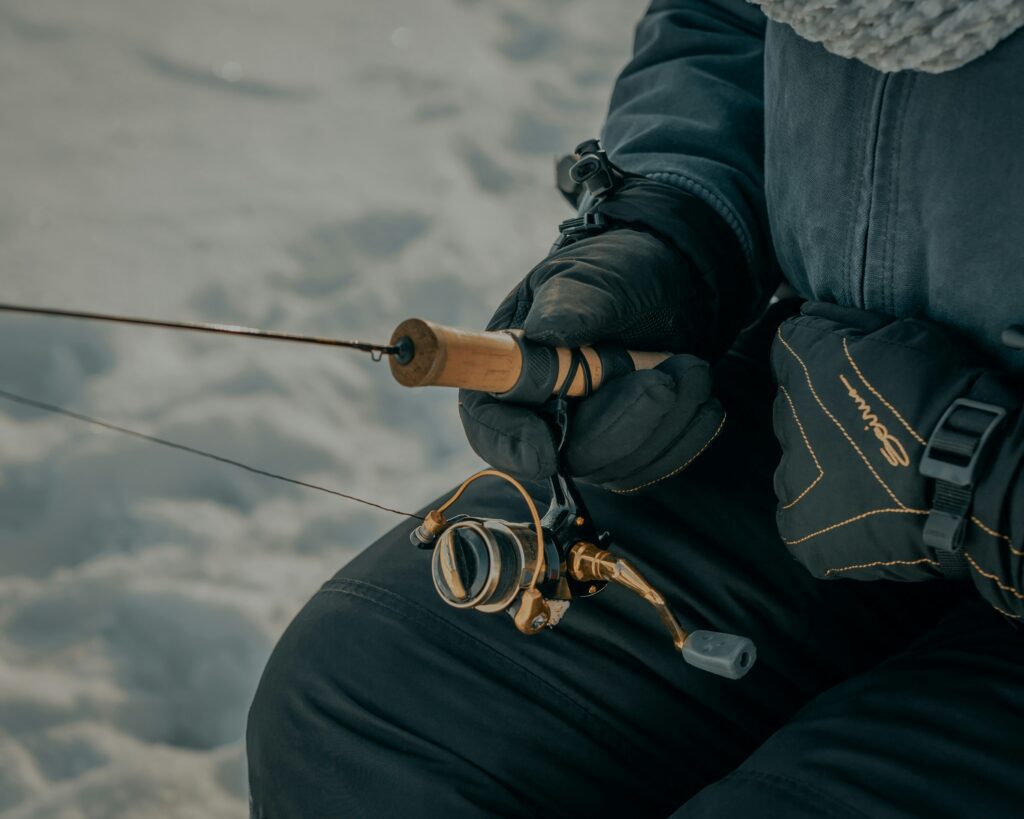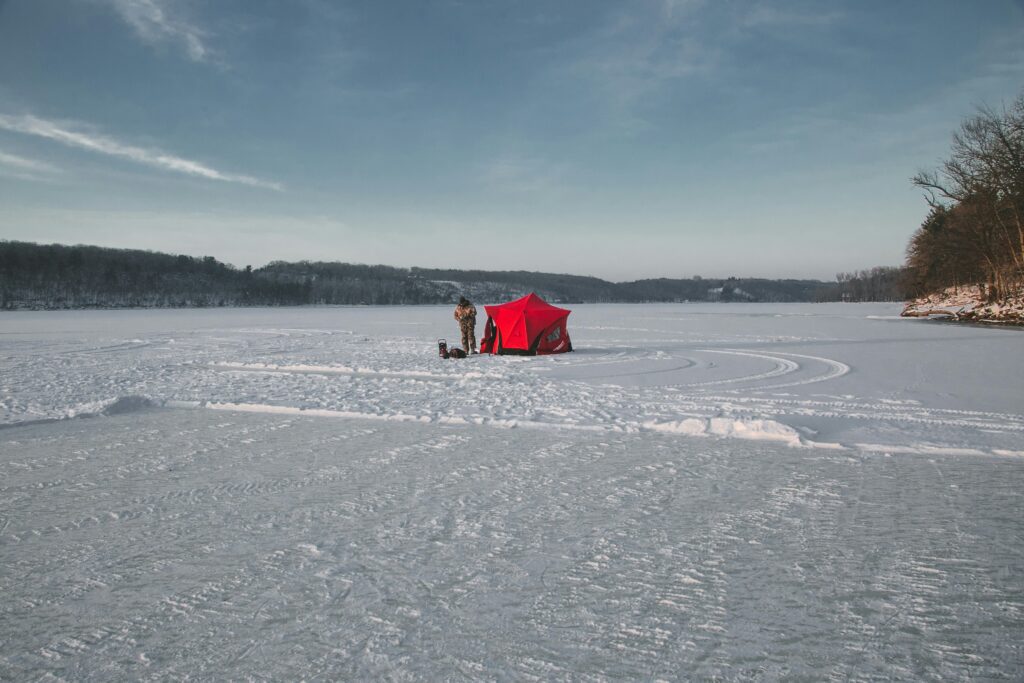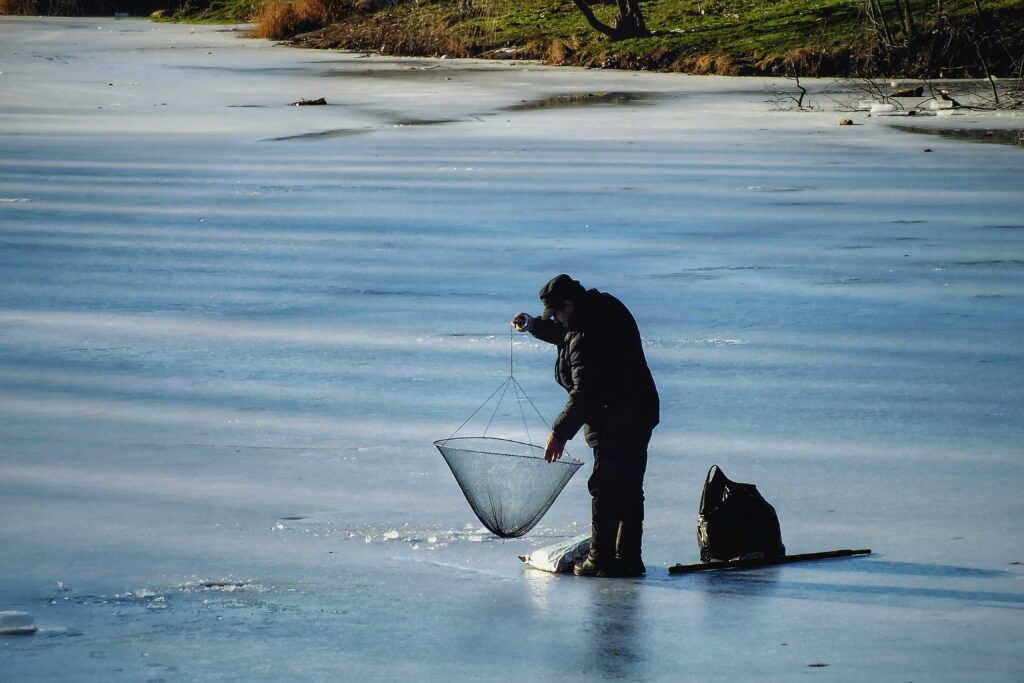Introduction: Understanding the Risks of Ice Fishing
Venturing out onto the frozen expanse for a day of ice fishing can be a serene experience, but it’s one where safety should never be on thin ice. Clad in your warmest gear, knowing the risks keeps you safe and the fish biting.
The Importance of Prioritizing Safety
Why should you always check the thickness of the ice before setting up your fishing spot? Ice thickness can be a clear indicator of potential danger. For instance, 4 inches of solid ice is generally considered safe for walking, but are you aware that activities like driving a vehicle onto the ice require at least 8-12 inches?
Having the right ice fishing safety gear is just as crucial. You’d want to have items like ice picks or life vests from trusted brands such as Frabill or Strikemaster – they could be lifesavers in an emergency situation.
Ever heard the phrase “dress to impress”? It’s not just a fashion statement; dressing in layers using materials like wool or modern synthetics can help prevent hypothermia, which is a real risk if you’re exposed to the cold for extended periods.
Remember, anyone can be cool but being cold and unsafe? Now that’s a no-go on the ice!
Preparing for Ice Fishing Safety

When you’re gearing up for a day on the ice, it’s critical to prioritize your safety. That means not only checking the ice for stability but also being equipped with the right gear. Let’s dive into how to do just that!
Checking Ice Thickness
Have you ever wondered how thick the ice should be to hold you safely? Before you set foot on a frozen lake, make sure the ice is thick enough to support your weight. Always carry a tool like an ice chisel or ice auger to check the thickness as you go.
Guidelines for Safe Ice Thickness
Did you know that ice thickness can vary even in a small area? Here’s a handy checklist for reference:
- For walking: At least 4 inches of clear, solid ice
- For snowmobiles or ATVs: 5-7 inches
- For cars or small trucks: 8-12 inches
- Larger vehicles: Over 12-15 inches
These guidelines are your first line of defense against the risks of ice fishing.
Using Ice Augers to Measure Thickness
When it comes to verifying ice thickness, an ice auger is your best friend. Brands like Eskimo and Strikemaster offer durable ice augers that can make the job much easier. Remember, clear ice is generally stronger than cloudy or white ice, which may contain air pockets.
Gathering Essential Safety Gear
Now, let’s talk gear. It’s like packing for a camping trip; you wouldn’t forget your tent, right? Make sure your ice fishing checklist includes essentials like hand warmers, a first aid kit, and a whistle.
Life Jackets and Personal Floatation Devices
How important is a life jacket for ice fishing? Very! It’s surprising, but even on ice, a life jacket could save your life if you fall in. Choose one that’s comfortable to wear over your cold-weather gear and doesn’t restrict movement.
Ice Picks and Self-Rescue Tools
In case you slip into the water, ice picks are a must for pulling yourself out. They’re small, easy to carry, and when you’re in a pinch, they’re a real lifesaver. Frabill has some reliable options you might want to check out.
Informing Others of Your Plans
Ever gone to a party and let your friends know where you’ll be? Think of ice fishing the same way. It’s key to tell someone about your fishing plans, including the exact location and your expected return.
Letting Someone Know Your Location
You don’t need a flare gun to signal your position, but you should definitely inform a buddy or family member about your fishing spot. If you’re heading to a popular area, chances are you can name drop a landmark or two.
Setting Check-In Times
Just like letting someone know when you’ll be home from a night out, set regular check-in times to update someone on your status. It’s a straightforward way to ensure peace of mind for both you and them.
Dressing for Cold Weather

When you’re ice fishing, staying warm is about more than comfort—it’s crucial for your safety. The right gear can mean the difference between a great day on the ice and a dangerous situation. Let’s make sure you’re geared up correctly!
Layering Techniques
The secret to enduring the cold is to layer your clothes effectively. Start with a moisture-wicking base layer—this keeps you dry, which is half the battle in staying warm. Add insulating layers, like fleece or wool, to trap heat. Finally, top it off with a windproof and waterproof outer layer to shield against the elements.
Choosing the Right Base Layer
Your base layer should be snug but comfortable, made of materials that draw sweat away from your skin. Materials like merino wool or synthetic fibers like polyester are excellent choices because they retain warmth when wet and dry quickly. Avoid cotton, as it loses its insulating properties when damp.
Insulating with Middle Layers
For your middle layer, think thick and warm. Fleece or down jackets are perfect for creating an insulation barrier. Remember, it’s all about trapping that precious body heat. Pieces that offer zippers or vents are a bonus as they allow you to regulate your temperature with ease.
Cold-Weather Apparel
Your outer layer should be tough enough to handle the harsh conditions you’ll face. Look for apparel with terms like “insulated,” “waterproof,” and “windproof.” Brands like IceArmor and StrikerIce offer suits specifically designed for ice anglers.
Insulated Boots and Cold-Weather Suits
Don’t forget your feet—frostbite isn’t friendly! Insulated, waterproof boots are a must. Quality boots designed for ice fishing can keep your feet warm all day. Also consider a full cold-weather suit, which is much more effective than individual clothing pieces at keeping you warm.
Essential Accessories for Warmth
Last but not least, accessorize for warmth! A warm hat, Waterproof gloves, and wool socks are non-negotiable. For extra safety, strap on a pair of ice cleats for traction and consider a thermal belt to store heat packs.
Remember, ice fishing is a blast, but staying safe and warm is what lets you cast another day!
Safe Practices on Ice
When heading out on the ice, your safety depends on being prepared and knowing how to navigate and set up your equipment properly. Let’s walk through each step so you can enjoy your ice fishing experience with peace of mind.
Walking and Moving Safely
Are your feet ready for the slippery challenge? It’s crucial to wear cleats or traction devices on your boots to prevent slips and falls on the ice. Something simple like Yaktrax can make all the difference.
Tips for Walking on Ice
Keep your center of gravity low and take short, shuffling steps. Always test the ice with a spud bar before proceeding. Remember, a minimum of four inches of clear, solid ice is generally safe for walking.
Navigating Uneven Terrain
Uneven ice can be deceptive. Watch for pressure ridges or ice heaves, which could be weak spots. A good rule of thumb is to avoid darker or discolored patches that indicate thin ice.
Setting Up and Using Ice Shelters
Your ice shelter is your home base, so choose a spot with even terrain. Hub-style shelters offer easy setup, but make sure they’re secured against the wind.
Anchoring and Securing Shelters
Once you’ve chosen your spot, use ice anchors to secure your shelter. Brands like Eskimo and Clam offer specially designed anchors that twist into the ice for a firm hold.
Proper Ventilation and Heating
Got a heater to warm up your space? Always ensure adequate ventilation to prevent carbon monoxide build-up. Cracking a window slightly open can keep the air fresh and safe.
Fishing Safety
Your fishing tactics should also be safe. Never fish alone and always inform someone about your location. Wear a life jacket or float suit by manufacturers like Striker to increase your chances of survival if you fall in.
Drilling and Maintaining Ice Holes
A reliable ice auger is key; electric models, like those from StrikeMaster, are convenient and fume-free. Keep ice holes clear of slush to prevent refreezing and tripping hazards.
Handling Fish Safely on the Ice
When you’ve got the catch on the ice, handle it with care. Use wet gloves to avoid damaging the fish’s protective slime coating, enhancing their chances of survival upon release.
Emergency Procedures

In the chill of winter, ice fishing can be a delightful adventure—but only if you’re prepared for mishaps. Do you know what to do if things go awry on the ice? Let’s equip you with critical emergency procedures to ensure you stay safe and can help others in need.
Self-Rescue Techniques
If you find yourself taking an unexpected plunge into icy waters, the key is not to panic. Focus on slowing your breathing and aim to keep your head above water. Remember, cold water shock can incapacitate you quickly, so fast action is vital.
- Stay calm: Control your breathing and avoid flailing to conserve energy.
- Get horizontal: Turn toward the direction you came from, as the ice was strong enough to hold you before.
- Kick, float, climb: Use a flutter kick to help you get horizontal on the ice, then pull yourself up onto solid ice.
Using Ice Picks to Pull Yourself from the Water
Having specialized gear like ice picks can be a lifesaver. Frabill Ice Safety Picks are an example of such equipment that’s designed to give you a good grip to haul yourself out of the water.
- Pierce the ice: Jab the ice picks into the ice edge firmly.
- Leverage your body: Use the picks as anchor points to help pull your upper body onto the ice.
The Huddle Technique for Heat Retention
If you’re with a group and waiting for rescue, the huddle technique is an effective way to conserve heat.
- Gather together: Get everyone to huddle close to minimize heat loss.
- Minimize exposure: Use your combined body heat and any available materials to reduce exposure to the elements.
Assisting Others in Emergencies
Helping someone else requires careful action to avoid putting yourself at risk.
- Call for help: If someone falls in, your first action is to alert emergency services.
- Reach, Throw, Row, Don’t Go: Use any object that extends your reach without you having to get too close to the weak ice.
Steps to Help Someone Who Has Fallen Through Ice
When someone else has fallen in, quickly assessing the situation and acting can be critical.
- Stay safe: Don’t approach the hole. Lie flat to distribute your weight and slide an object out to the victim.
- Instruct the victim: Guide them to kick their feet and use the object you’ve provided to assist in pulling themselves up.
Administering Basic First Aid
Once the person is out of the water, they are at risk for hypothermia. Provide basic first aid while help is on the way:
- Get to shelter: Move the person to a warm, sheltered area if possible.
- Dry and insulate: Remove any wet clothing and wrap the person in warm blankets.
Weather Considerations
Essential to the success of any ice fishing trip, weather conditions can make or break your experience. Keeping an eye on the forecast and understanding how to respond to adverse weather is crucial for safety on the ice.
Monitoring Weather Conditions
Have you ever been caught off guard by a sudden snowstorm? Regularly checking the weather before and during your trip is a must. Use reliable weather apps or a weather radio to monitor updates; some apps even provide hourly forecasts to help you plan your day accordingly.
Staying Informed About Current Weather
Why do you think it’s important to know the weather down to the hour while you’re fishing? Ice conditions can rapidly change with temperature fluctuations. Bookmark websites that provide up-to-date local weather conditions or sign up for alerts from services like the National Weather Service to stay in the know.
Recognizing Signs of Unsafe Conditions
Are you aware that fog forming on the ice can be a sign of danger? Familiarize yourself with indicators of weakening ice like water seepage, cracks, and ice that sounds hollow when tapped. Remember, if the ice shows any signs of melting or deterioration, it’s time to retreat to safer ground.
Responding to Sudden Changes
What if the weather turns on you? Whether a sudden drop in temperature or an incoming storm, be prepared to react. Keep a safety kit handy, including items such as hand warmers, a float suit, and a whistle to signal for help.
Strategies for Evacuating the Ice
Do you have an exit plan? In case the weather turns from fish-friendly to threatening, it’s crucial to have a strategy to evacuate the ice. Make sure you:
- Carry a map of the ice with marked safe paths
- Have a buddy with you; they can help in emergencies
- Identify multiple points where you can safely leave the ice
Finding Shelter in Extreme Conditions
What’s your game plan if you can’t leave the ice immediately? Look for shelters or have an ice shanty ready as a refuge against the biting wind and cold. Pack extra blankets and a portable heater for added warmth and comfort.
Remember, safety is your top priority when ice fishing—never compromise on it!
Post-Ice Fishing Safety
After your ice fishing expedition, it’s crucial to handle the transition back to warmth properly to avoid cold-related injuries and properly care for your gear. Let’s walk through how to thaw out and store everything correctly, so you’re ready for your next adventure on the ice!
Thawing Out and Treating Cold-Related Injuries
When you’re back from the cold, gradually warming up is key. You might be tempted to jump into a hot shower, but slowly warming your body prevents shock to your system. Start with room-temperature surroundings and use blankets. If you have any numbness or stiffness, avoid rubbing those areas to prevent tissue damage.
Dealing with Frostbite and Hypothermia
Caught a case of the ‘nippy fingers’? If you suspect frostbite, gently warm the area in lukewarm water—not hot! For hypothermia signs, like shivering uncontrollably or slurred speech, seek medical attention promptly. Hypothermia can be tricky because it affects your thinking, making self-diagnosis difficult.
Warming Up Safely
Once in safe, indoor conditions, sip on a warm beverage and change into dry clothes. Resist the urge to place cold extremities on hot surfaces or use direct heat sources which can cause burns. Let your body’s circulation do the work!
Gear Maintenance and Storage
Your ice fishing gear has been good to you, so be good to it. Start by inspecting everything for damage. For your safety gear like ice cleats, check for wear and tear; they’ve got to have your back—or rather, your feet—next time too.
Cleaning and Drying Equipment
Got a slush-covered auger? Wash off any debris from your tools and allow them to air dry completely to prevent rust. Your fishing rods and reels will appreciate a gentle wipe down as well, so they’re not sticky or gritty the next time you reel in a big one.
Proper Storage for the Off-Season
As the season wraps up, stow your gear in cool, dry places. Your fishing line can become brittle if exposed to extreme temperatures, and your electronics, like fish finders, need a secure spot away from moisture and dust. It might be goodbye for now, but proper storage means a quicker ‘hello’ when the ice calls your name again.
Safely Enjoying the Thrills of Ice Fishing

Are you ready to take on the icy challenge and experience the quiet, serene world of ice fishing? It’s all about preparation and knowing the ins and outs of ice safety.
Remember, ice thickness is paramount. For a solo angler, you want at least four inches of clear, solid ice, while snowmobiles or ATVs require five to seven inches. This isn’t just a suggestion—it’s a safety rule backed by experts to keep you above water, not in it. To gauge ice safety, use this handy checklist:
- 4 inches thick for walking
- 5-7 inches for snowmobiles or ATVs
- 8-12 inches for a small car (but driving on ice is often discouraged)
Gear Up! Dressing in layers is your best defense against the cold. And don’t forget your life jacket—it can be a literal lifesaver in an emergency, providing critical minutes to react and reach safety. Ice picks and cleats are also your allies – the former helps you claw back onto the ice and the latter keeps you steady on your feet.
Lastly, be vigilant. Keep an eye out for mushy snow or visible cracks that indicate unstable conditions. And remember, local insights are incredibly valuable – locals know their lake’s quirks like no one else.
So, stay safe, be smart, and enjoy the crystal-clear silence that comes with dropping a line through a hole in the ice. Tight lines, fellow ice angler!
FAQs (Frequently Asked Questions)
Preparing for ice fishing involves not just packing the right gear but also knowing how to use it to ensure your safety. Let’s dive into some of the most common questions you might have.
What Safety Gear Do I Need for Ice Fishing?
When it comes to gear, safety is your top priority. Always carry:
- Personal floatation device (PFD): Just in case the ice gives way.
- Ice picks: Vital for getting a grip on the ice to hoist yourself out of the water.
- Throw rope: A lifeline to rescue someone else without putting yourself at risk.
- Ice cleats: For better traction to prevent falls.
Respected brands like Clam and Frabill offer safety equipment tailored for ice fishing. Remember to pack a first aid kit augmented with ice-specific safety gear.
How Should I Dress for Extreme Cold while Ice Fishing?
Dressing in layers is key. Start with a moisture-wicking base layer, add an insulating mid-layer, and top it off with a waterproof and windproof outer layer. Brands like Carhartt and Columbia offer durable and warm clothing options. Keep in mind that your extremities lose heat the fastest, so quality gloves, hats, and boots are essential.
What Should I Do if Someone Falls through the Ice?
In the unfortunate event someone does fall through the ice, keep calm. Call for help immediately. Encourage the person to kick their feet while horizontally pulling themselves onto the ice. You can offer assistance with a throw rope or branch, staying a safe distance away to avoid also falling in. After they’re out, find shelter quickly to prevent hypothermia.
How Do I Stay Safe in Changing Weather Conditions While Ice Fishing?
Changing weather can quickly turn a serene day on the ice into a risky venture, so always check the forecast before heading out. If you notice a sudden drop in temperature, wind picking up, or snow falling heavily, it is time to pack up. Keeping an eye on the sky while on the ice and staying updated with a portable weather radio can save your life.








